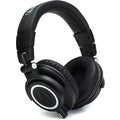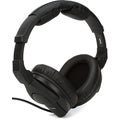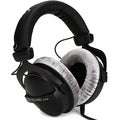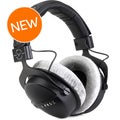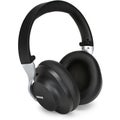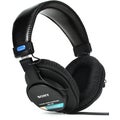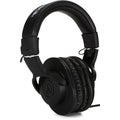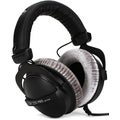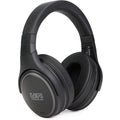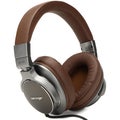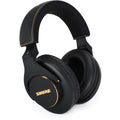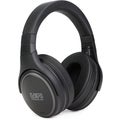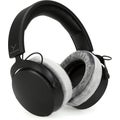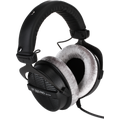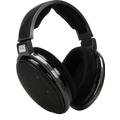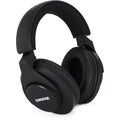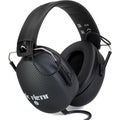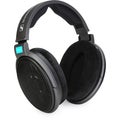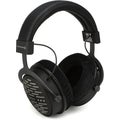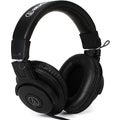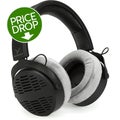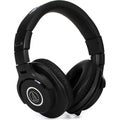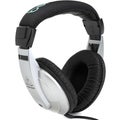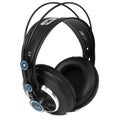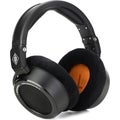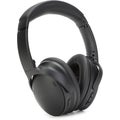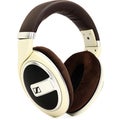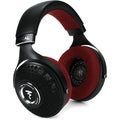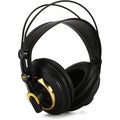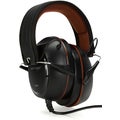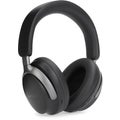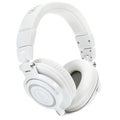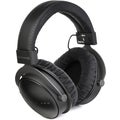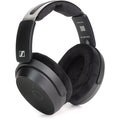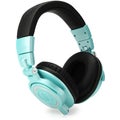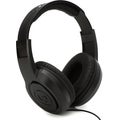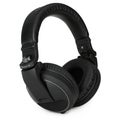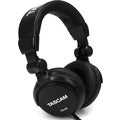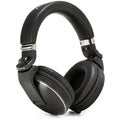Headphones
Read our Headphones Buying GuideGet More at Sweetwater
Refine Your Search
Availability
Brand
- JBL Lifestyle (65)
- Beyerdynamic (61)
- Sennheiser (55)
- Audio-Technica (45)
- AKG (38)
- Behringer (28)
- Shure (27)
- Yamaha (17)
- Austrian Audio (15)
- V-Moda (14)
- Focal (13)
- Bowers & Wilkins (12)
- Direct Sound (12)
- Pioneer DJ (12)
- Mackie (11)
- AIAIAI (10)
- Neumann (8)
- Samson (8)
- Apple (7)
- Bose (7)
- Sony (7)
- Vic Firth (7)
- Avantone Pro (6)
- Mark Levinson (6)
- Listen Technologies (5)
- Roland (5)
- Audix (4)
- Beats (4)
- Meters (4)
- PreSonus (4)
- Clear-Com (3)
- Denon (3)
- HEDD (3)
- KRK (3)
- Korg (3)
- Miktek (3)
- Alesis (2)
- Focusrite (2)
- Metrophones (2)
- Steven Slate Audio (2)
- TASCAM (2)
- Ashdown (1)
- Dekoni Audio (1)
- On-Stage (1)
- Rode (1)
- Rupert Neve Designs (1)
Price Range
- Under $25 (13)
- $25 to $50 (35)
- $50 to $100 (81)
- $100 to $200 (171)
- $200 to $300 (103)
- $300 to $500 (84)
- $500 to $750 (32)
- $750 to $1000 (5)
- $1000 to $1500 (15)
- $1500 to $2000 (7)
- $2000 to $3000 (2)
- $3000 and Over (2)
Financing What is this?
Type of Deal
Series
- Beyerdynamic DT (49)
- AKG K (37)
- JBL Lifestyle Tune (32)
- Audio-Technica M (23)
- Sennheiser Studio Headphones (22)
- Sennheiser Audiophile Headphones (16)
- JBL Lifestyle Live (15)
- JBL Lifestyle Quantum (15)
- Shure SRH (15)
- Audio-Technica ATH (14)
- Pioneer DJ HDJ (12)
- Austrian Audio Hi (11)
- Mackie MC (11)
- Yamaha HPH (10)
- Shure AONIC (9)
- AIAIAI TMA-2 (8)
- Beyerdynamic MMX (8)
- Focal High-End Headphones (8)
- Neumann NDH (8)
- Samson SR (8)
- Apple AirPods (7)
- Sennheiser Momentum (7)
- Sony Professional Headphones (7)
- V-Moda Crossfade (7)
- Audio-Technica BPHS (6)
- Bose QuietComfort (5)
- Focal Pro Headphones (5)
- Roland RH (5)
- Audix A Series (4)
- Austrian Audio Headsets (4)
- Avantone Pro Planar (4)
- Beats Beats Studio (4)
- Behringer HPM (4)
- Direct Sound DS (4)
- Listen Technologies Listen RF (4)
- Meters Meters (4)
- Behringer BH (3)
- Behringer HPX (3)
- KRK KNS (3)
- Miktek DH (3)
- Shure BRH (3)
- AIAIAI Tracks (2)
- Avantone Pro Mixphones (2)
- Behringer HPS (2)
- Beyerdynamic Amiron (2)
- Direct Sound EX (2)
- Focusrite Vocaster (2)
- PreSonus Eris (2)
- Ashdown Meters (1)
- Listen Technologies ListenTalk (1)
- Vic Firth American Classic (1)
Type
Connectivity
Open/Closed What is this?
Fit Style What is this?
Noise Attenuation
Impedance What is this?
Application
- Studio (72)
- Audiophile (34)
- Gaming (32)
- Streaming (23)
- Podcasting (21)
- Broadcast (13)
- Drumming (9)
- Intercom (2)
- Office (1)
Driver Size What is this?
Color
- Black (245)
- White (27)
- Blue (15)
- Gray (12)
- Red (11)
- Brown (10)
- Silver (9)
- Green (3)
- Tan (2)
- Purple (1)
Cable Type What is this?
Cable Length What is this?
Detachable Cable What is this?
Related Searches
Focal Clear Mg Professional Open-back Reference Studio Headphones
Professional Open-back, Circumaural Monitor Headphones with M-shaped Magnesium Domes and Internal/External Honeycomb Grilles, Microfiber/Leather-Covered Aluminum Headband, and Memory Foam EarpadsYou can only compare four products at a time.
If you want to compare another product, please remove one of your earlier choices.Please select more items to compare
About Headphones
Today, headphones set the standard for the ultimate portable - and personal - way to listen to music. And with good reason: ever since the first stereo headphones were produced in the 1940s, ear-to-ear audio has seen drastic improvements in technology, quality, and selection. Before that, early headphones were used primarily in the world of communication; radio, telegraph, and telephone operators relied on them long before modern DJs and mixing engineers did. Luckily, headphones have come a long way since Nathaniel Baldwin made the first pair by hand in his kitchen in 1910. (Fun fact: the US Navy ordered 100 pairs prior to World War I.) What was once a crude, uncomfortable listening experience is now a revelation of clarity, comfort, and privacy.
Circumaural vs. supra-aural headphones
There’s a huge array of different brands and models, each with their own strengths and advantages. On a broader level, headphones can be divided up into two main types: circumaural and supra-aural. Circumaural headphones completely enclose the ear, while the earcups of supra-aural headphones sit on the surface of the ear. Since circumaural headphones completely encompass the ear, they’re often better for isolating sound. When researching circumaural and supra-aural headphones, you’ll see certain models advertised as either “open” or “closed.” With closed headphones, a hard, shell-like cover seals the outside of the earcups, isolating listeners in their own sonic world — free from outside noise. Open headphones leave the earcups exposed to the outside world, without any sort of insulating shell; thus, there’s less of a sound barrier between a listener and his or her surroundings. The Sennheiser HD 280 Pro Studio is an iconic example of closed, circumaural headphones, while the Audio-Technica ATH-M2X is a good example of an open, supra-aural model.
What should I consider when choosing headphones?
If you’re just getting started with your headphone collection, or if you’re seeking an additional pair for different use cases, knowing the buying factors while browsing can greatly help narrow your options. Here are the main factors to consider when choosing headphones.
- Recording vs. engineering: When it comes to a set of cans, recording artists and audio engineers tend to look for different specs. A singer or rapper may prefer closed-back or semi-open headphones for monitoring themselves while recording and for reducing audio bleed back into the microphone in order to get a clean performance. Recording artists or producers can also get away with selecting headphones that don’t have the flattest frequency response. Meanwhile, audio engineers often prefer open-back headphones with a flat and accurate frequency response for reference with their other studio monitors. Open-back headphones offer wide stereo separation, which enables audio engineers to make critical mixing decisions in their sessions. One potential downside is that open-back headphones can leak audio, making them less than ideal for use when recording or when working in a noise-sensitive environment.
- Impedance and headphone amplification: Impedance is simply the ohm measurement for how much amplification is required to power and use your headphones. All headphones require amplification to some degree — a common impedance level being 32 ohms. Audio engineers demanding more accurate frequency responses and sound production will use headphones that require a higher impedance level, thus requiring more amplification. Impedance matching is important so that you know which headphones are compatible with your devices.
- Wired vs. wireless: Some recording artists and engineers very much enjoy the convenience of wire-free monitoring, which is quite liberating if you work across a large studio console or you often move one pair of headphones between rooms. Be aware that Bluetooth functionality can introduce latency, which may require further configuration to be usable when tracking or recording.
- Driver size: The world of headphone driver count and size can get convoluted quickly. The most important thing to know is that driver size generally correlates with improved frequency response and stereo imaging in your headphones. Additional drivers typically only need to be considered when shopping in-ear and live sound monitoring.
-
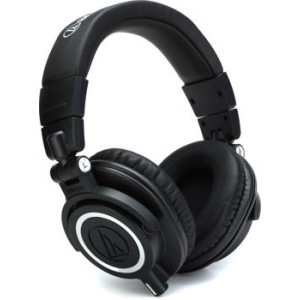
Audio-Technica ATH-M50x Closed-back Studio Monitoring Headphones
★★★★½ 230 reviews
$149.00 -
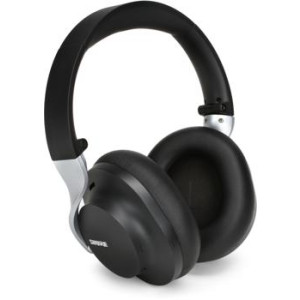
Shure AONIC 40 Wireless Noise-canceling Headphones - Black
★★★★ 21 reviews
$199.00 -
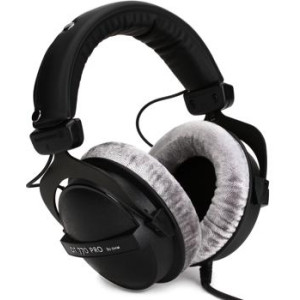
Beyerdynamic DT 770 Pro 80 ohm Closed-back Studio Mixing Headphones
★★★★½ 189 reviews
$169.00 -
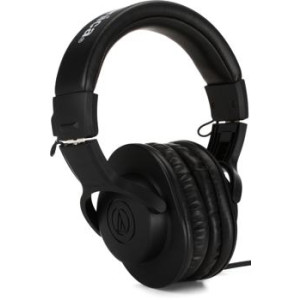
Audio-Technica ATH-M20x Closed-back Monitoring Headphones
★★★★½ 148 reviews
$49.00 -
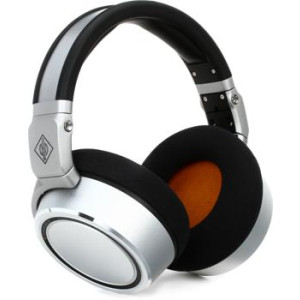
Neumann NDH 20 Closed-back Studio Headphones
★★★★½ 61 reviews
$549.00
Finding your perfect set of headphones depends on how you plan to use them. Some headphones, called “studio” headphones, are built for professionals who demand detail, range, and sensitivity from their listening experiences. Sony MDR-7506 Studio Headphones are a popular example — these headphones are a staple in recording studios worldwide. Studio headphones are often closed and circumaural; they offer mixers, musicians, and engineers the best-quality sound, with maximum isolation from outside noise. This isolation also means that musicians don’t have to worry about their headphone mix bleeding into microphones, which is invaluable for pro-quality recording. Of course, once the music has been tracked, studio headphones offer an incredibly lush, high-fidelity listening experience to fans and pros alike.
On the other hand, educators may be attracted to the super-affordable Samson CH70 Reference Headphones, which bring personalized audio into any classroom. If you’re a professional DJ, take a look at the Direct Sound EX-29 Isolating Headphones, offering thick padding, isolation, and incredible clarity — even in the noisiest clubs. In fact, isolation headphones are commonly used at shooting ranges to protect users’ ears from loud gun blasts. When manufacturers decided to install drivers into these headphones, isolation models became a favorite of drummers, who rely on them for a way to hear other musicians amid the high SPLs of a drum kit.
Learn MoreWhat are the most popular brands for Headphones on Sweetwater.com?
What are the most popular Headphones on Sweetwater.com?
Why shop Headphones at Sweetwater.com?
With a massive selection of Headphones, free shipping, a free 2-year warranty, 24/7 access to award-winning support - and more - Sweetwater gives you more than any other retailer! If you have any questions about Headphones, make sure to give your personal Sales Engineer a call at (800) 222-4700.

